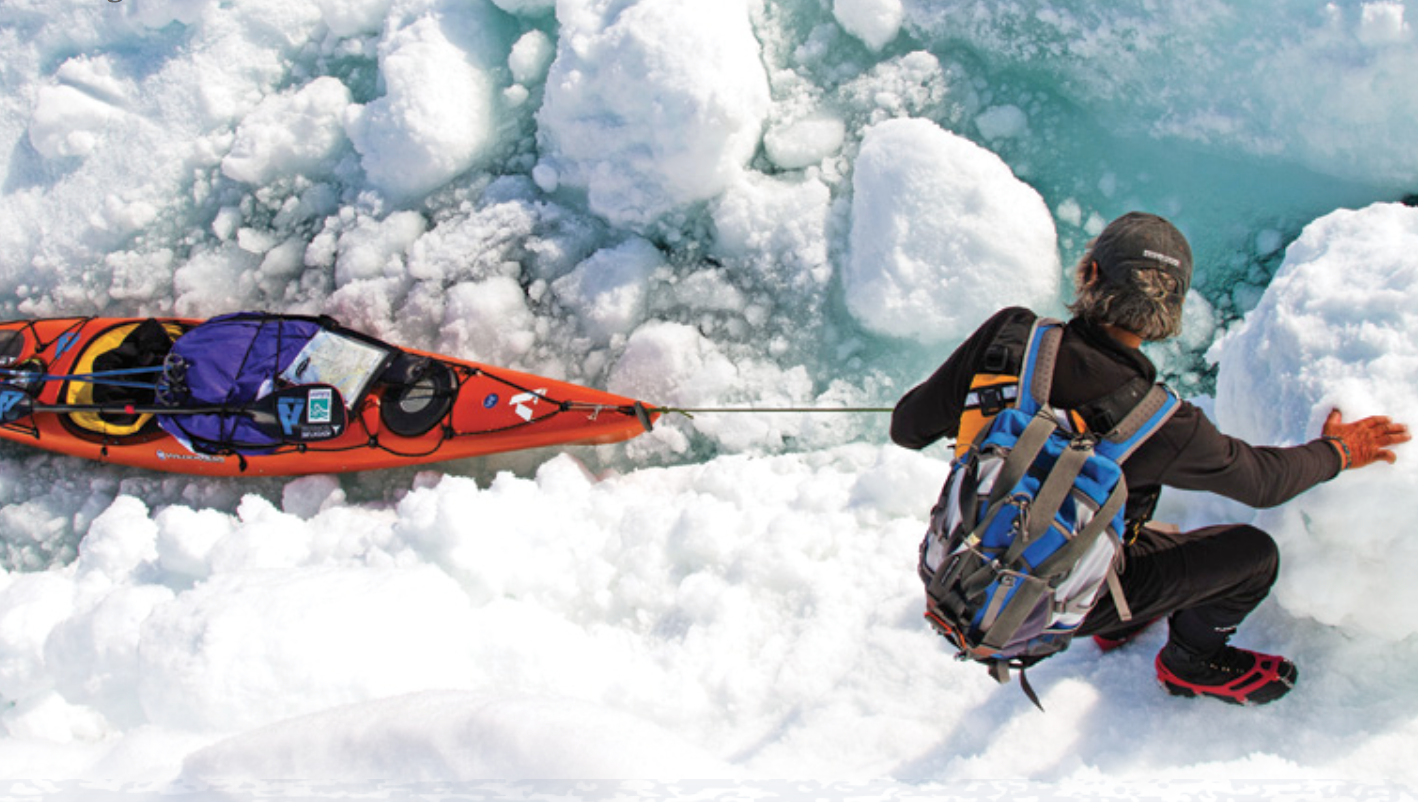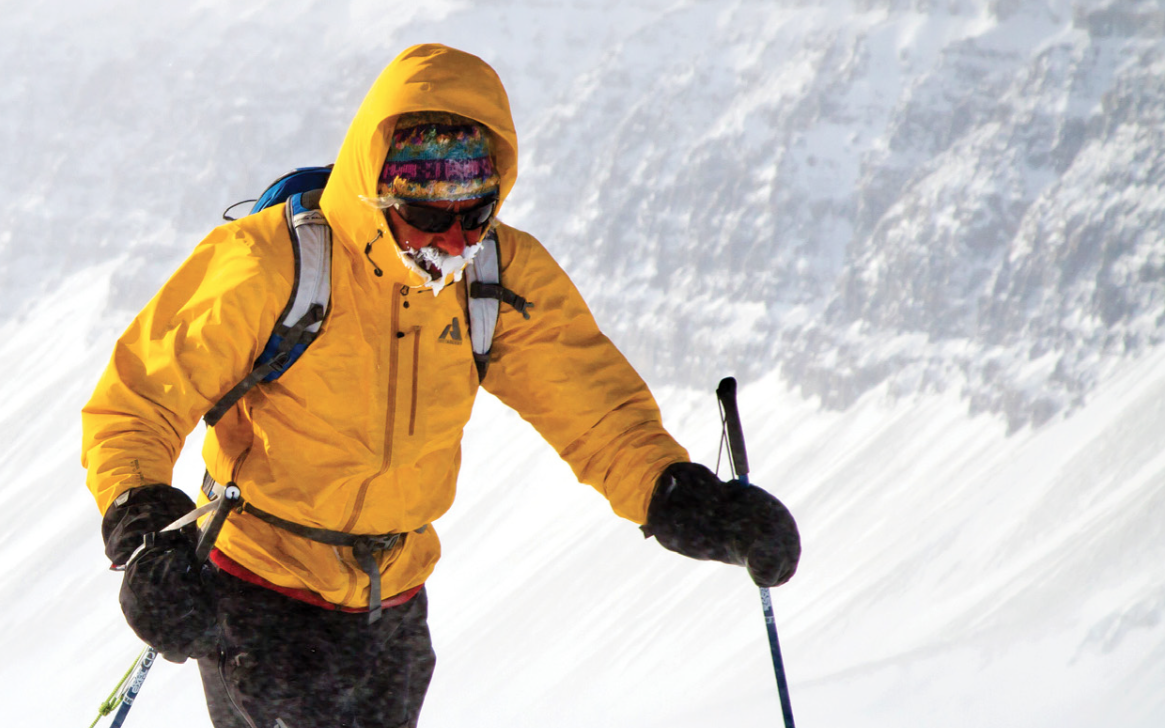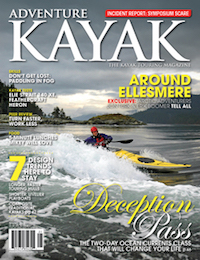On August 19, 2011, veteran explorer Jon Turk and expert whitewater kayaker Erik Boomer became the first people to circumnavigate Ellesmere Island, a mountainous, ice-smothered landmass in the Canadian High Arctic. Nearly the same area as Great Britain, Ellesmere has just two permanent settlements, 500 miles apart and home to 146 souls between them. Boomer and Turk’s incredible journey spanned 1,500 miles, 104 days, four uniquely demanding environments, and not a few unspoken doubts. At times, the intensity of their undertaking was so great that it seemed superfluous, even counterproductive, to discuss their deepest fears and emotions.
Now, from the safety of home, Turk and Boomer ask each other the questions that they couldn’t voice on the ice.

Turk: We left the Eureka weather station on day 24 with 50 days of food and 300 miles to our next cache, near Ward Hunt Island. Knowledgeable explor- ers had warned us that the ice on the northwest corner of Ellesmere might be very rough and that we might be slowed to traveling a few miles or even a few hundred yards a day. If the ice turned out to be that rough, we would have starved before reaching our food drums. Why did you continue on with me in the face of such uncertainty and potentially dire consequences?
Boomer: This was my biggest concern of the whole expedition. The environment was so harsh and unpredictable that rescue options were few and far between. Even if we could make it to one of the few viable landing strips, there was no guarantee that the weather would allow a plane to reach us.
So unless we were extraordinarily lucky, we might have had to wait a week or more for an aircraft. If we were starving or injured, that might be too long.
Paradoxically, this risk factor is the main reason I joined you on this expedition. I found myself going through the same mental process that I go through before paddling over a huge un-run waterfall. Identify the dangers and decide if I can hit the line that will lead to a clean drop. The major difference is that kayaking waterfalls lasts only a few seconds. On this expedition the nervous uncertain feeling was a nagging daily emotion.
The unknown, difficult nature of the North Coast kept the expedition exciting and fun. No day was monotonous. We skied to exhaustion every day, knowing that if we met or exceeded our 15-miles-per-day average, we would be saving food, time and energy for the possibility of rough ice and slow travel ahead.
As it turned out, we exceeded our expectations and made great time getting to our food cache near Ward Hunt. Actually, I think the traveling became a lot tougher later.
We could worry all day about the “what ifs.” Adventure is about accepting the challenge to go into the unknown.

Boomer: Just as we were crossing the 80th parallel, passing from the High Arctic into the Polar latitudes, a white wolf spent a considerable amount of time with us in camp. You had a unique way of interpreting this experience. I’d like to know more about this perspective and your take on our intimate relationship with the natural landscape.
Turk: When I was five years old, my family moved from New York City to rural Connecticut. At a very early age, I remember venturing alone into the woods until I was scared that I would not find my way home. So I’ve been wandering around in natural environments for over 60 years. After enough time, the fear melts away and the spiritual connection with nature dominates.
Between 2000 and 2005, I embarked on five expeditions to Vyvenka, a small Koryak village in northeast Siberia. I traveled with indigenous hunters and was guided on hallucinogenic and healing journeys by an old shaman, Moolynaut. The Koryak people see nature as animate, alive and magical. Every animal, every rock, every blade of grass has soul and communicates with humans.
According to a scientific worldview, we would view the white wolf that slept only a few feet from our tent as a purely physical event. But the Koryak people would have interpreted it as a magical communication with the wolf spirit, the guard- ian of a passage into a new realm. There is no right or wrong. We can never ask the wolf what it was thinking or know its intentions. But I have found that life is so much more rewarding and satisfying if we embrace the magic that I believe is flying around us all the time.
Turk: We were essentially trapped for 17 days in the Robeson Channel as winds and currents compressed the North Pole icepack into the narrow Nares Strait between Ellesmere and Greenland. During that time, we occasionally made forays onto moving ice. Several times, we found it necessary to jump across fields of small, tippy, floating ice floes. There was always the danger of falling in or a pan tipping over and being crushed as the ice chunks compressed together. You are 40 years younger than I. During these critical moments, you were both stronger and more agile. How did you feel about the age gap?
Boomer: The age gap was actually one of my favorite parts of this expedition. It amazes me how similar we are and how well we were able to relate to each other.
In the more mellow times we found great companionship. People have asked me, “Being around just one person that long, you must have not talked some days?” On the contrary, we had great conversations every day. I really enjoyed your storytelling and often prodded you with questions to keep the stories coming.
In critical times, like when we were venturing across the broken ice, I think we both agreed that losing each other was the biggest concern. Not only would it have been unthinkably tragic to have an accident, but we also shared group gear that was vital to our survival. For example, I carried the sleeping bags, while you had the tent. We depended on each other so much; it was essential to travel as a single unit.
Because of my youth, I could move faster across the ice, but what we were attempting was not a sprint. We traveled over a half marathon every day for 104 days—keeping a good pace was critical and you set a great pace. I feel like the age gap galvanized our relationship and helped keep us in balance.

“I felt I could continue forever, do another lap around the island if we had to.”
Boomer: We experienced challenges and difficult conditions that pushed our bodies to the limit. At what point did you feel most physically spent?
Turk: It’s tempting to say that it was most challenging where the ice was roughest. On the northeast coast, Cape Hecla comes to mind. Intense north winds had forced the North Pole icepack into formidable pressure ridges. There were no flat surfaces and all day long we were lifting and lowering our boats— heavily laden with 50 days of food—over ice ridges 30 feet high. Sometimes we worked for half an hour to gain only 30 yards horizontally. Yet, truthfully, I was no more tired at the end of a day of travel on rough ice than I was at the end of a day of moving on smooth ice. Every day, I gave the expedition everything I had.
After the first day, I wrote in my journal, “Completed: 15 miles. To Go: 1,485.” Then I took a quick mental survey of all the little aches and pains throughout my body, and concluded that I’m 65 years old and there was no way I could complete the circumnavigation. I thought seriously about saying to you, “Hey, Boomer. This is really dumb. I can’t do this. I’m going to turn back tomorrow morning. Sorry.” But I just couldn’t end my career so ignominiously.
Fourteen hundred miles later, we were losing sun angle and shivering cold every day. I was exhausted, totally spent, but I had pushed so hard for so long, through so many barriers, that I felt invincible. I felt I could continue forever, do another lap around the island if we had to.
The day before we finished, on a 15-mile crossing, I started out paddling strongly. As we neared land, a fog rolled in. You were ahead, so I tried to paddle harder to catch up because I didn’t want to lose you. But my arms wouldn’t work. It wasn’t fatigue; it was something way beyond that. I shouted to you, “Hey, Boomer, you gotta slow down. I’m bumping up against some wall I’ve never witnessed before. It’s eerie, it’s scary; I feel like I’m nearing breakdown.”
{loadposition PTG_AK_Midcontent}
Final Thoughts
We finished the journey in late summer, paddling over a placid sea into Grise Fiord, our starting point three-and-a-half months before. With the nose of my kayak just touching the beach, I sat for a minute, reflecting on the passage.
I had paddled strongly into town, angry with myself for being wimpy the day before. I thought my trials were over—all I needed to do was catch the flight home and eat the garden vegetables that my wife, Nina, had been growing all summer. Expeditions had become part of my soul, and now I was ready for the long, treacherous and demanding journey into geezerhood.
Then, 39 hours later, my body sunk suddenly and inexplicably into metabolic breakdown. My kidneys stopped working, my blood pressure went through the roof and my blood chemistry was all wrong. I was dying. We called Global Rescue to send an air ambulance.
Boomer was beside me during the emergency flight south. I looked into his eyes; he had experienced a long distance expedition for the first time and I could see that he was excited about the op- portunities and adventures awaiting him. I realized that I was content, at last, to pass the baton, man the satellite phone and be the expedition dispatch for young men and women who continue to push the frontiers.
Turk and Boomer can be reached at: jonturk.net and wayofthenorth.com. They wish to thank expedition sponsors Eddie Bauer/First Ascent, Polartec, Confluence Watersports and Kokatat.
All photos this page: Erik Boomer.
 This article first appeared in the Spring 2012 issue of Adventure Kayak Magazine. For more great content, subscribe to Adventure Kayak’s print and digital editions here.
This article first appeared in the Spring 2012 issue of Adventure Kayak Magazine. For more great content, subscribe to Adventure Kayak’s print and digital editions here.



